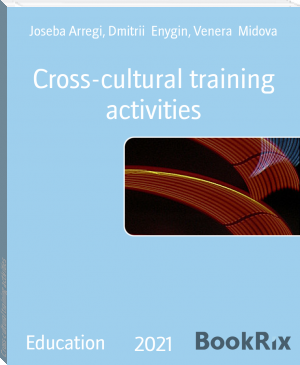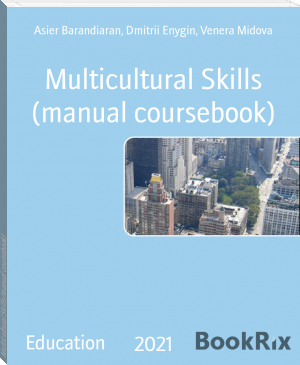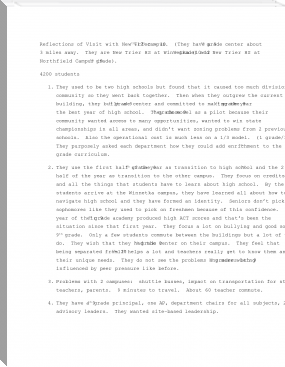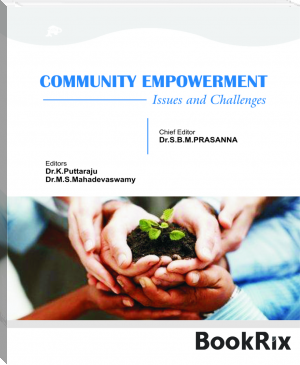Theories of intercultural education by Joseba Arregi, Asier Barandiaran, Dmitrii Enygin, Venera Midova (great novels of all time txt) 📕

Book online «Theories of intercultural education by Joseba Arregi, Asier Barandiaran, Dmitrii Enygin, Venera Midova (great novels of all time txt) 📕». Author Joseba Arregi, Asier Barandiaran, Dmitrii Enygin, Venera Midova
NARRATIVES ON DIVERSITY FROM DIFFERENT SOURCES
Cultural diversity is not a new phenomenon. But narratives on diversity, interpretations and practices are changing continuously. Diversity is a concept widely used in everyday conversations and policy discourses. The current perspective on diversity has shifted from celebrating, appreciating or managing diversity to inclusion and development of an intercultural society. This perspective goes beyond the celebration of diversity per se and organising “folkloric events”, to creating frameworks for the affirmation of cultural identity in all aspects of life and for an equal basis in personal development, as well as for the contribution to the development of society as a whole.
Institutional definitions of cultural diversity
In 2001, UNESCO adopted the Universal Declaration on Cultural Diversity (UNESCO 2002). The first two articles define cultural diversity as follows.
Article 1 – Culture takes diverse forms across time and space. This diversity is embodied in the unique- ness and plurality of the identities of the groups and societies making up humankind. As a source of exchange, innovation and creativity, cultural diversity is as necessary for humankind as biodiversity is for nature. In this sense, it is the common heritage of humanity and should be recognised and affirmed for the benefit of present and future generations.
Article 2 – In our increasingly diverse societies, it is essential to ensure harmonious interaction among people and groups with plural, varied and dynamic cultural identities as well as their willingness to live together. Policies for the inclusion and participation of all citizens are guarantees of social cohesion, the vitality of civil society and peace. Thus defined, cultural pluralism gives policy expression to the reality of cultural diversity. Indissociable from a democratic framework, cultural pluralism is conducive to cultural exchange and to the flourishing of creative capacities that sustain public life.
Page 18 T-Kit 4 Intercultural learning
The motto of the European Union, “United in Diversity”, aims to promote the idea that “via the EU, Europeans are united in working together for peace and prosperity, and that the many different cultures, traditions and languages in Europe are a positive asset for the continent”.10
In 2008, the Council of Europe adopted the“White Paper on Intercultural Dialogue”, stating that the intercultural approach offers a forward-looking model for managing cultural diversity, based on individual human dignity:
Managing Europe’s increasing cultural diversity – rooted in the history of our continent and enhanced by globali- sation – in a democratic manner has become a priority in recent years. How shall we respond to diversity? What is our vision of the society of the future? Is it a society of segregated communities, marked at best by the coexistence of majorities and minorities with differentiated rights and responsibilities, loosely bound together by mutual igno- rance and stereotypes? Or is it a vibrant and open society without discrimination, benefiting us all, marked by the inclusion of all residents in full respect of their human rights? The Council of Europe believes that respect for, and promotion of, cultural diversity on the basis of the values on which the Organisation is built are essential conditions for the development of societies based on solidarity. (Council of Europe 2008b)
Other perspectives on diversity
Going beyond these institutional definitions and the values they are guided by, we must acknowledge that different people have different attitudes towards diversity. And these attitudes are often defined in terms of “positive” and “negative”. Those who consider diversity to be a positive aspect see it as a source of progress and try to make use of its potential. Those who consider it a negative aspect see it as a source of conflict.
This can be pictured well through Schulz von Thun’s value-square model.11 This model looks at concepts such as “diversity”, and searches for their opposites, as well as for an exaggeration of both.
Figure 1: Schulz von Thun’s value-square model
Diversity
Confusion Loss of identity
Source: Adapted by Nadine Lyamouri-Bajja
tension of opposites
Homogeneity
Monotony/uniformity Loss of uniqueness
According to this model, too much diversity could lead to confusion or loss of identity, whereas too much homogeneity could lead to monotony, uniformity and loss of individuality. This model enables us to get rid of a “right or wrong” approach, and rather to consider the potential of “both”, thus recognising the needs and limitations of both diversity and its opposite, as well as the risks of reaching extremes in both cases. Furthermore, the words chosen by people help us understand the hidden fears or representations around a word such as “diversity”, which then makes it easier to deconstruct or transform. These value squares can be a constructive way of entering dialogue with people who strongly disagree on themes related to intercultural learning.
When speaking about diversity, there is both the risk of dilution (to consider every aspect of life, every expe- rience, every difference in the concept of diversity) and the risk of essentialisation (to consider that a person who belongs to a certain group that is“different”necessarily represents the viewpoint of that particular group). In the first case, there is too much emphasis on the individuality to the detriment of group belonging, while in the second case there is too much emphasis on group belonging and presupposed homogeneity within groups. For example, in the first case we might believe that we have diversity in a group of heterosexual men with the same religious and cultural background just because they had very different life experiences. In the
10. See https://europa.eu/european-union/about-eu/symbols/motto_en, accessed 3 October 2017. 11. See https://en.wikipedia.org/wiki/Four-sides_model, accessed 14 December 2017.
Intercultural learning: theories, contexts, realities Page 19
Exaggeration
Exaggeration
second case, we might have the tendency to always look at the African or Australian participant, or search their approval when speaking about things related to Africa or Australia, as if they would represent the point of view of an entire continent.
In the same way, one of the core dilemmas of intercultural learning concerns dogmatism versus relativism. On the one hand, dogmatism signifies that there is only one way of doing things, that “our way is the right way”. In relation to culture, it includes an assimilative idea that people from other cultures should behave in a certain way in order to fit in. On the other hand, cultural relativism implies that all ways of behaving or acting are acceptable if they are defined as cultural practices: “if this is their culture, then it’s OK”. Both extremes are dangerous. Whereas dogmatism leads to a form of fundamentalism and closeness, cultural relativism can lead to perpetuation of unjust or inhumane practices. One way of dealing with this dilemma is through the human rights perspective. The human rights framework allows and supports manifestations of diversity, but at the same time protects people from extreme practices or hurtful behaviours.
Diversity is also viewed differently depending on the particular group it refers to. Some people value certain cultural groups more than others. Therefore, they see cultural diversity as positive only in certain conditions that correspond to their hierarchical view of cultures. They are open to intercultural encounters with the valued groups, but not with those considered inferior or coming from a state that is in conflict with their own state.
All human beings are different and unique in their individuality, talents, potential, desires, but they are equal before the law, as citizens and with regard to their human rights:
He who reduces political language to difference only will come out as an individualist and social Darwinist, he who does the same with regard to equality will end up as collectivist. It is only by keeping the concepts of difference and equality in balance that one can speak of a fair and just society (Council of Europe 2008a).
Multiculturalist and interculturalist approaches to diversity
One of the recurrent themes of the consultations for developing the “White Paper on Intercultural Dialogue” was that old approaches to the management of cultural diversity (such as multiculturalism) were no longer adequate to societies in which the degree of that diversity was unprecedented and ever growing.
Multiculturalism, an approach that focuses on the preservation of different cultures or cultural identities within a unified society, as a state or nation, is a policy focused on sharing a territory and living next to each other, without necessarily interacting with each other.
Multiculturalism is now seen by many as having fostered communal segregation and mutual incomprehen- sion, as well as having contributed to the undermining of the rights of individuals – and in particular women – within minority communities, perceived as if these were single collective actors.
If multiculturalism was a policy aimed at respecting cultural identities of people living in the same social space, interculturalism goes beyond mere coexistence, towards living together in a space of respect, but also of interaction, communication and genuine exchanges. “In this understanding, interculturalism has already processed the lessons of multiculturalism’s limitations, replacing a static parallelism with an emphasis on dynamic interaction and exchange” (Ohana and Otten 2012: 164).
The intercultural perspective first requires us to recognise that reality is plural, complex, dynamic and changing, and that interaction is an integral part of all lives and cultures. Then it asks us to ensure that such interaction fosters mutual respect and the enrichment of mutually supporting communities and individuals, rather than the strengthening of relationships based on domination and rejection. The aim is therefore to search for the truth through dialogue and to work towards mutual understanding (Olafsdottir 2011).
Interculturality refers to the capacity to experience cultural otherness, and to use this experience to reflect on matters that are usually taken for granted within one’s own culture and environment. Interculturality involves being open to, interested in, curious about, and empathetic towards, people from other cultures, and, using this heightened awareness of otherness, to evaluate one’s own everyday patterns of perception, thought, feeling and behaviour in order to develop greater self-knowledge and self-understanding (Council of Europe 2009a).
In a multicultural society diversity is tolerated, but not valued. In an intercultural society all citizens (beyond any categorisation such as national, migrant or minority) have the opportunity both to affirm their culture and to participate in dialogue and democratic processes with the rest of society.
In recent years, the term transcultural has (re)appeared, to recognise the fluidity of cultures and of the “bor- ders” between cultures. It is defined as “involving, encompassing, or combining elements of more than one
Page 20 T-Kit 4 Intercultural learning
culture”,12 a process from which a new, complex and composite reality emerges – a reality that is not a mixture of cultural elements, but a new cultural phenomenon. It is a way for individuals to overcome determinations of their own culture.
With globalisation, there are more and more individuals that do not identify with a specific cultural framework, having lived in various contexts and interacted with diverse individuals on a daily basis, thus creating their own combination of cultural elements with which they identify. Some promoters of transculturalism are critical of both multiculturalism and interculturalism; others recognise the merits of interculturalism in combating discrimination, rejecting ethnocentrism, encouraging respect for differences and supporting access to fun- damental rights for members of minority groups, but consider that transculturalism is needed to overcome the polarity of cultures (Intercultural Institute of Timisoara 2017).
Transculturalism focuses on individual rights, freedoms, responsibilities and action. The critics of this approach highlight its failure to take into account power relations and social realities that shape people’s identities and give them different degrees of freedom to combine and interpret cultural factors.
Some questions to reflect on
f How do you perceive diversity in your context? Which aspects of diversity are visible and which are invisible? f What is the link between diversity and discrimination?
f Are the young people you work with aware of diversity in society? Which forms of diversity? Which ones not? f Are you aware of any initiative that helps strengthen interactions between different groups in society?
WHAT IS INTERCULTURAL LEARNING REALLY ABOUT?
The main purpose of intercultural learning – to reduce ethnocentric perspectives, fight prejudices and promote solidarity actions that support equality in human dignity and respect for the plurality of cultural identities –





Comments (0)